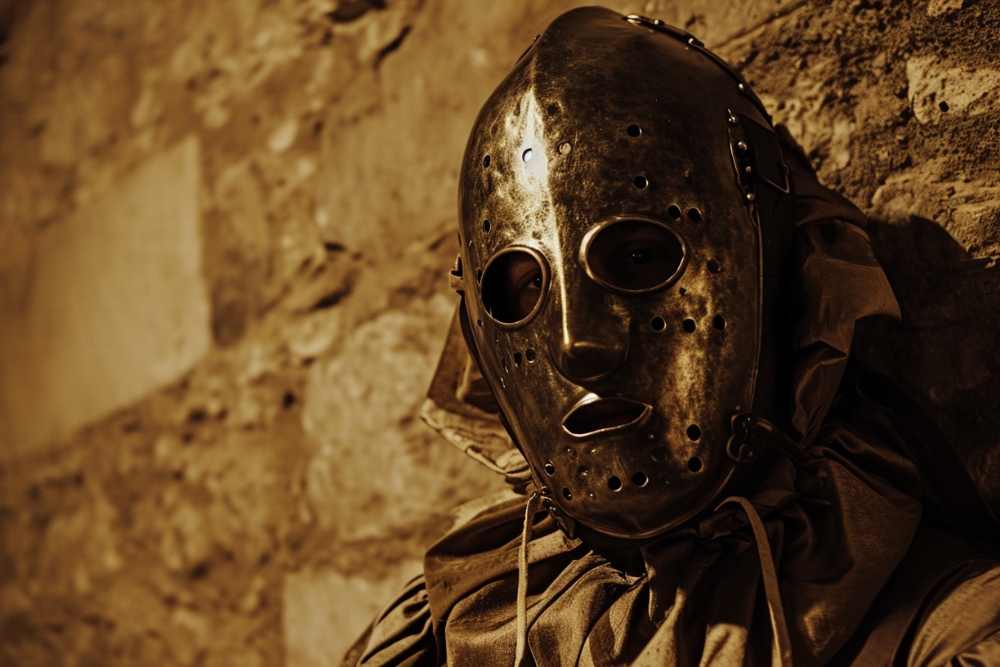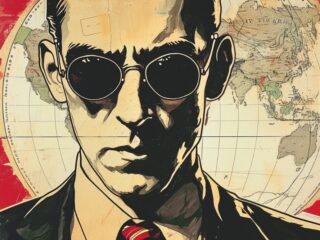Step into history’s dimly lit corridors, where secrets and mysteries lurk in the shadows. Imagine a figure shrouded in darkness, their face hidden behind an impenetrable mask. The legend of the Man in the Iron Mask has captivated minds for centuries, a puzzle that remains unsolved today. Who was this mysterious prisoner condemned to a life of obscurity in the time of Louis XIV?
As you embark on this journey, prepare to unravel the enigma, discover the theories and speculations that have swirled around this enigmatic figure, and uncover the lasting legacy and cultural significance of the Man with the Iron Mask. But be warned, the answers may elude you, leaving you hungry for more, desperate to unravel the truth behind this captivating tale.
Historical Context
To fully understand the mystery surrounding the Man in the Iron Mask, it is crucial to delve into the historical context of his imprisonment. The political climate of 17th-century France, particularly within the royal court, played a significant role in shaping the events that led to his confinement.
During the reign of Louis XIV, France experienced a period of absolute monarchy characterized by the consolidation of power in the hands of the king. The royal court in the opulent Palace of Versailles served as the epicenter of political intrigue and power struggles. It was within this volatile environment that the Man in the Iron Mask found himself entangled.
The political climate of the time was marked by tensions and rivalries between the various factions vying for influence in court. As such, individuals who posed a threat to the king’s authority or who were seen as potential sources of rebellion were often imprisoned, their identities hidden to prevent any potential rallying behind them.
The Man in the Iron Mask’s unknown identity and the secrecy surrounding his imprisonment suggest that he was a figure of significance, someone whose existence could potentially challenge the authority of Louis XIV. The historical context of political turmoil and power struggles within the royal court sheds light on the enigma surrounding this mysterious prisoner.
Imprisonment and Masking

Having established the historical context surrounding the Man in the Iron Mask’s imprisonment, exploring the intricacies of his confinement and the purpose behind his enigmatic mask is imperative. The Man in the Iron Mask was subjected to unique masking techniques that added to the mystery of his identity. The most famous depiction of his mask is the iron mask itself, which covers his entire face, leaving only small openings for his eyes, nose, and mouth. This mask was not only physically restrictive, but it also had profound psychological effects on the prisoner.
The purpose behind the use of the mask was multifaceted. Firstly, it served as a means of preventing the Man in the Iron Mask from being recognized. Concealing his face ensured that even if he were to escape or be released, his true identity would remain hidden. Secondly, the mask was a form of punishment and confinement in itself. The discomfort and restricted vision caused by the mask would have made everyday tasks challenging, further isolating the prisoner from the outside world.
The psychological effects of the mask cannot be underestimated. Being constantly masked would have deprived the Man in the Iron Mask of a basic human need – the ability to communicate and connect with others through facial expressions. This isolation and lack of social interaction may have had a detrimental impact on his mental well-being, leading to feelings of loneliness, depression, and frustration.
Theories and Speculations
Numerous theories and speculations have emerged over the years in an attempt to unravel the enigma surrounding the identity of the Man in the Iron Mask. Conspiracy theories abound, suggesting that the masked prisoner was a high-ranking noble or even a royal family member.
One popular theory proposes that the Man in the Iron Mask was the twin brother of King Louis XIV, who was hidden away due to the threat he posed to the throne. This theory gained traction due to the striking resemblance between the two brothers. Another theory suggests that the prisoner was an illegitimate son of Cardinal Mazarin, the chief minister of France during Louis XIV’s reign. This theory is supported by historical evidence of Mazarin’s illegitimate children and the secrecy surrounding their existence.
Identity revelations have also influenced the speculation surrounding the Man in the Iron Mask. Some claim that the prisoner was a high-ranking military officer who had knowledge of state secrets and was locked away to prevent him from revealing them.
Others believe the masked man was a political prisoner, possibly a disgraced noble or a conspirator against the king. The lack of concrete evidence has fueled these speculations, and the mystery surrounding the Man’s true identity in the Iron Mask continues to captivate historians and conspiracy theorists alike. Until definitive proof is uncovered, the identity of this enigmatic prisoner will remain one of history’s greatest unsolved mysteries.
Famous Candidates
Several notable individuals have been proposed as potential candidates for the Man’s identity in the Iron Mask. Over the years, historians and scholars have put forth various alternate identities, each with its own set of supporting evidence.
One famous candidate is Eustache Dauger, a valet who served as a prisoner in the Bastille. Historians argue that Dauger’s secretive imprisonment and the similarities between his life and the circumstances of the Man in the Iron Mask make him a strong contender.
Another popular candidate is Matthioli, an Italian diplomat imprisoned by Louis XIV. Supporters of this theory point to Matthioli’s knowledge of state secrets and his connection to political intrigue as reasons for his possible confinement.
Additionally, theories have also been proposed suggesting that the Man in the Iron Mask could have been a younger brother of Louis XIV, an illegitimate son of the king, or even a twin of Louis XIV himself. However, these speculations lack substantial evidence and are considered less likely. Despite the numerous famous candidates put forward, the Man’s true identity in the Iron Mask remains one of history’s greatest mysteries.
Legacy and Cultural Significance
The legacy and cultural significance of the Man in the Iron Mask is a topic that has captivated historians, scholars, and the public alike for centuries. One aspect of this legacy is the numerous artistic representations inspired by the mysterious prisoner. From Alexandre Dumas’ famous novel “The Man in the Iron Mask” to various films and plays, the enigma surrounding the identity of the masked man has fueled the imagination of artists. It continues to be a source of inspiration for creative works.
However, the cultural significance of the Man in the Iron Mask goes beyond artistic representations. The historical controversies surrounding his identity have sparked intense debates and speculation. Some theories suggest that he was a high-ranking nobleman, while others believe he may have been a political prisoner or even a twin brother of Louis XIV. These controversies have piqued historians’ interest and contributed to the enduring fascination with the Man in the Iron Mask in popular culture.
The cultural significance of the Man in the Iron Mask is also evident in how his story has become a symbol of oppression, secrecy, and the abuse of power. His image has been used in political cartoons, literature, and even in modern-day protests to represent the struggle against tyranny and the fight for justice. The Man’s enduring legacy in the Iron Mask lies in his ability to transcend time and continue to capture the imagination of people from all walks of life.
Conclusion
Well, congratulations! After reading about the man in the iron mask, you know absolutely nothing about his true identity. Despite countless theories and speculations, history has kept this secret locked away. It’s ironic, isn’t it? In a world full of information at our fingertips, some mysteries still refuse to be unraveled. So, next time you ponder historical enigmas, remember the man in the iron mask, forever shrouded in the shadows of uncertainty.




